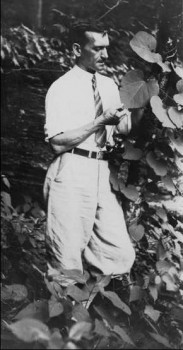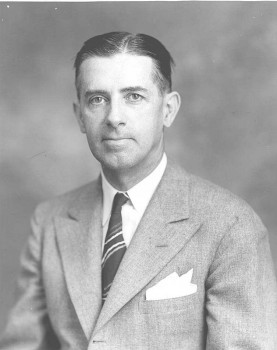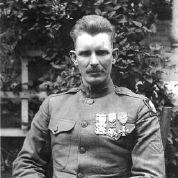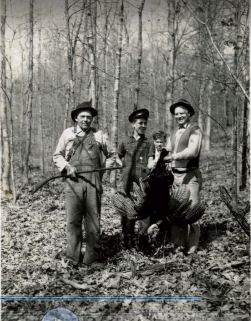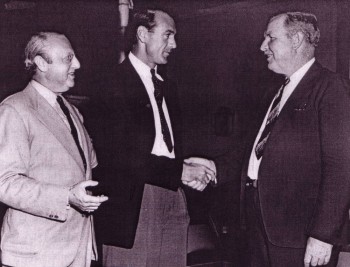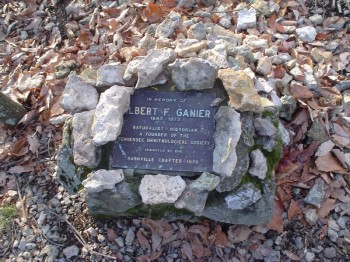Albert Franklin Ganier (1883-1973) was descended from sugar and cotton planters. He grew up in Madison Parish, Louisiana and Vicksburg, Mississippi. His grandfather Francis was a Frenchman, son of a Revolutionary, who came to Louisiana in 1820 to harvest sugar cane. His father Elie, a sergeant in General Bragg’s 18th Louisiana Infantry, farmed 1,500 acres of cotton.
When Hollywood movie producer, Jesse Lasky, came to Tennessee in April of 1940 to plan his Warner Bros film, Sergeant York, Governor Prentice Cooper recommended that Lasky take his friend Ganier on the expedition.
The film was about the most celebrated hero of World War I, Tennessee’s own Sergeant Alvin C. York. York won fame by leading seven men in a daring attack against a line of machine gun batteries protecting the strategic Decauville Railroad depot. In recounting the action, York said,
And those machine guns were spitting fire and cutting down the undergrowth all around me something awful. And the Germans were yelling orders. You never heard such a racket in all of your life. I didn’t have time to dodge behind a tree or dive into the brush… As soon as the machine guns opened fire on me, I began to exchange shots with them. There were over thirty of them in continuous action, and all I could do was touch the Germans off just as fast as I could. I was sharp shooting… All the time I kept yelling at them to come down. I didn’t want to kill any more than I had to. But it was they or I. And I was giving them the best I had.
In the melee, he had run out of rifle ammunition and was forced draw his service revolver when charged by six German soldiers. Before they could reach him, he had killed all six.
When the encounter ended, York and his handful of men had captured 132 German soldiers who they marched back to American lines.For his valor, York received nearly 50 decorations from several nations, including the Medal of Honor from his own country.What makes York’s story particularly amazing is that he had been a conscientious objector because of his deeply-felt religious beliefs. His prayerful approach to war served as a metaphor to the United States as the nation considered entry into World War II.
The purpose of Lasky’s trip to Tennessee was to scout locations and character types in the hills of Pall Mall, York’s home territory. Governor Cooper recently had helped establish the Tennessee Historical Society and Ganier, a founding member, seemed a logical choice to accompany Lasky to make photographs. His beautiful black and white stills compliment the color, 16 mm home movie shot by Lasky’s 20 year-old son, Billy.
As a side note, it turns out that Jesse Lasky relied heavily upon Governor Cooper during the negotiations with York for his approval of the film. Cooper was a close friend of York’s and gave York as much counsel as he gave Lasky. For instance, Cooper had attended the 1939 Atlanta premier of Gone With the Wind, had met the author Margaret Mitchell, and had struck up a correspondence with her. Mitchell was paid $50,000 for the movie rights to her book – with no percentage of gross receipts (although, after the wild success of the film, Selznick paid her an additional $50,000). Regardless, Mitchell and her descendants made millions off book sales.
Interestingly, the deal struck by York and his country lawyer John Hale for the rights to Sergeant York was $50,000 plus two percent of gross – which York used to build a Bible School for mountain children. The Cooper/Mitchell correspondence may have played a role in the negotiations. At any rate, Jesse Lasky and Prentice Cooper became friends. After the producer signed a contract with York, he gathered his son Billy, with camera, and writer Harry Chandlee to learn more about York’s life in Tennessee. His first call was to Prentice Cooper who arranged for Albert Ganier to join the group as still photographer.The centerpiece of Billy’s film and Ganier’s collection of stills is a turkey shoot staged by York attended by a large group of mountain men bearing long flintlock rifles. This was the prototype of the turkey shoot replicated on the Warner Brothers sound stage which memorably appears in the finished film.
By the way, at 20 years old, Billy Lasky was an accomplished falconer and a member of the Audubon and other California ornithological societies. He may have known of Ganier. In any case, Ganier joined the entourage which resulted in hundreds of stunning black and white photos documenting the geography, people, and places around York’s home community.
For Albert Ganier, the York experience was just an interesting footnote to a remarkable record of public service. Among his other contributions, he cofounded the Nashville Children’s Museum, served as President of the Tennessee Historical Society which supervised the restoration of the Belle Meade Mansion, was a key figure in the establishment of the Great Smoky Mountains National Park, and served as the historian on a project to locate the final segment of the Natchez Trace.
In 1978, a monument was dedicated in his honor at RadnorLake for his many efforts in behalf of conservation.


